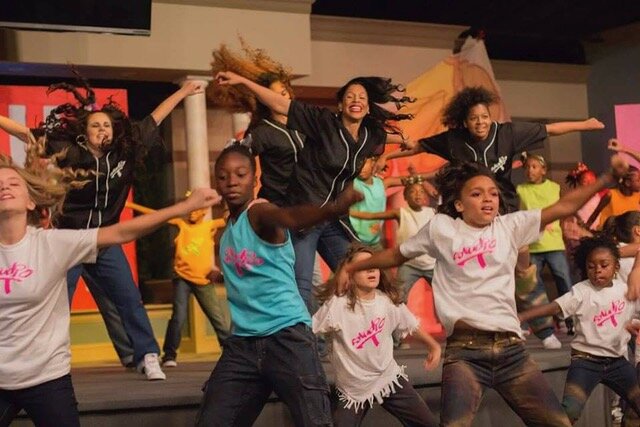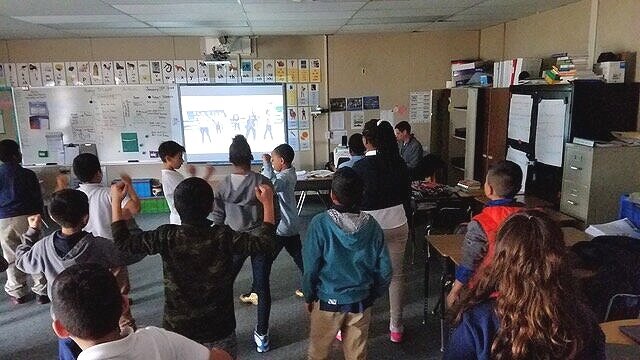Raising the Roof: How the Arts Can Lift Up Communities and Rebuild the Economy in the Post COVID-19 Era
Posted by Apr 09, 2020

Ms. Tamaira Sandifer
In this time when daily life is disrupted, it’s more important than ever to tell the stories of how art impacts our neighborhoods. Tamaira Sandifer, or “Miss Tee” as her students call her, is a walking testament to the transformative power of dance. She knows what it’s like to grow up with scarcity and how self-expression through movement is a survival skill.
Americans for the Arts member Californians for the Arts spoke with Miss Tee, who also serves as vice chair of the Americans for the Arts Arts Education Council, about the vital role of art programs in under-resourced neighborhoods and how its link to the creative industry provides an opportunity for economic restoration. A version of their conversation is published here; read the full interview on Californians for the Arts’ blog as part of their #CAArtsChampion campaign.

Tell us a little bit about your program and how you developed it.
I've been teaching dance in Sacramento for over 15 years now. This year I will be celebrating 32 years as an arts educator. Growing up, in Richmond, CA, we didn’t have dance studios, because no one could afford it, we came together as a community in the fight to survive and dance was a huge part of that. In 1999 there were so many of us who relocated to Sacramento with the surge in affordable housing and we brought our creative culture with us.
Sacramento was a very conservative city and lacked a lot of the culturally rich programs that we were accustomed to in the Bay Area. Our youth needed it and thrived in it. I opened Studio T Urban Dance Academy in 2005; it was your traditional brick-and-mortar dance space. By 2012, we started losing kids to third-party homicide, teen pregnancy, drug and alcohol abuse, and a different juvenile predator surfaced: suicide. We had never experienced this level of hopelessness among our youth.
So, with the help of my business mentor, I changed my company model and shifted Studio T to mobile programming, becoming partners and providers for major school districts in Northern California. We discovered, very quickly, that the youth couldn’t get enough of it. Because you can't turn on any social media platform, any video game, television show, or movie without seeing dance in it and without a routine going viral.

Dance is part of their vocabulary as young people, it’s their language already.
Right! Dance is a social acceptance tool for our kids. More importantly, it is a self-expression tool. We teach in community centers, churches, after-school programs, and one of the amazing things that started happening was that we saw students go pro. What traditionally was very difficult for them, particularly youth from low socioeconomic status, [who] don’t have access to auditions in New York or L.A. In 2005-2006 we started leveraging a new online platform called YouTube. It became the great equalizer for us and gave us access to casting directors and industry entertainers.
We started learning how to edit videos and sending them out– well, it opened the door to the professional realm for us. We have kids featured and winning major dance shows like So You Think You Can Dance, World of Dance, Ellen. We also have kids who perform and tour with artists like Bruno Mars, Justin Bieber, Rihanna, Chris Brown, J-Lo, Britney Spears, and more.
We discovered we weren't just “putting on shows,” we’re actually changing the trajectory of these kids’ lives and their families.
How does the success of these kids affect the neighborhood and the community at large?
Typically, in highly trauma-informed environments, what they’re going through is not often expressed. The level of anger, stress, and abuse they deal with, sometimes, even for us, is unbearable. When they have the ability to get it out—and in a safe space, a creative space—it helps them choose to take on tomorrow. We also supply basics like hygiene items and healthy snacks to take home. It renewed hope and our families started to soar creatively, academically, and as a family—this builds a tribe, if you will, which has impacted entire communities.
The second major thing, and something we heavily focus on, is the monetization of their creative talents. Entrepreneurship is not necessarily taught but happens to be an organic part of survival. We call it “hustle.” We teach them how to build a brand using social media, how to market their gifts and talents, and how to get paid for it. Beyond dance we teach them how to edit video, graphic design, photography, sound and lighting engineering, costume and merch design and production, hair and make-up for entertainment, and so much more. This training has created creative career pathways for community youth and their parents, not just professionally, but with local unions and, again, in the e-commerce community. Many of them couldn’t initially afford college; this gave them a quality trade to earn a living as they pursue other professional opportunities.

How has COVID-19 impacted the programs and the communities that you're working with? What are you seeing right now?
It has been tough. Many of our youth go to school because it’s safe and they can eat. And I’m not implying that every family environment is unsafe or abusive, but I am saying the probability of that being the case is significantly higher with the added stress on families. COVID-19 has heightened the stress levels in lower-income families and put people in extreme survival mode. If you’re not on the top of the socioeconomic ladder, this is a very scary time with lots of uncertainties. Removing vital systems of support like school and community programs throws people into a fear-filled tailspin.
Youth in under-resourced communities don’t have access to technological resources that help them in their education. I know the expectation is all we can learn online. Well sure, if you have the technology at home to learn online. Many of my families have single parents. Some of my kids are not even raised by their parents. They’re raised by grandma or auntie or a community guardian. And most often, there are several kids. So how does a single parent or single guardian oversee the education online with limited technology for multiple children while looking for income?
Some have learning challenges that are only really met with special services at the school site. When you cut that off, learning, growing, creating ceases. That’s a highly stressful environment for the parents, right?
I understand what's happening and I appreciate what all that our civic leaders are doing. This is such a sensitive time and they really are trying to solve this crisis. But in the same breath, it’s creating these other consequences.
What should we be doing right now or what should we be doing in terms of keeping these programs and these art nexus communities alive right now?
Well, I can tell you what we've done. We started doing a lot of arts integration work back in 2007 with a couple of different school districts, and we found that because of the shift in budgets teachers began teaching P.E. To support them, we build a hip-hop dance-inspired, web-based learning platform called PassToClass.com. It began as a P.E. and rainy-day recess alternative for teachers. Because all the classrooms have these awesome smart boards, teachers were able to get the kids moving with our on-demand dance in the classroom.

Because of COVID-19, we offered free access to PassToClass.com to all our school partners as a fitness and creative expression resource for distance learning. We’ve got teacher tips on there, motivational moments, and sessions we call brain breaks, which are short “groove” sessions that help youth, and parents, with boredom.
We need to expand access as much as possible right now. How do we go about doing that? I’ll start with this: every household has a cell phone. No matter what class or community you’re in, they have a cell phone. The bulk of what we’re doing is making sure that we’re tapping into every social media platform. They are all designed for e-connection and give the ability to do video posting and group chats. All these different social media platforms are very accessible to our families.
We also use videos, email, and our web presence to get solutions to our families. There’s a huge gap in the information dissemination from our civic leaders to our more marginalized communities. We’ve found there needs to be double the time and effort to get information out there.
So, you’re saying that these government agencies need to be working more closely with organizations like yours in order to keep kids safe and informed about COVID-19?
Right. They’re all trying to survive still. Some of my students go on tour, they come back, they don't know they can get unemployment. They keep hearing about the stimulus but they’re like, what's a stimulus, right? What's a census? There's a lot of defining and educating that's happening now. I get the benefit of doing that through the arts using video which makes is fun, understandable, and palatable.
Partnering with creative nonprofits that have tight community ties and boots on the ground means our under-resourced communities get the information and resources they need to stay safe. We are a trusted source.

Our arts organization acts as a bridge to different communities and social classes. Dance, in this case, is the binding agent that creates a safety net, a birthing place, an unsegregated place. The freedom to innovate and express themselves through this community is because we’re leveraging who we are and what we have access to, and we’re connecting, we’re working together. Fostering a village that raises healthy, physically strong, and emotionally balanced youth.
It presents a transformative opportunity when we go to rebuild local economies.
Again, this is the amazing capacity of the arts.





